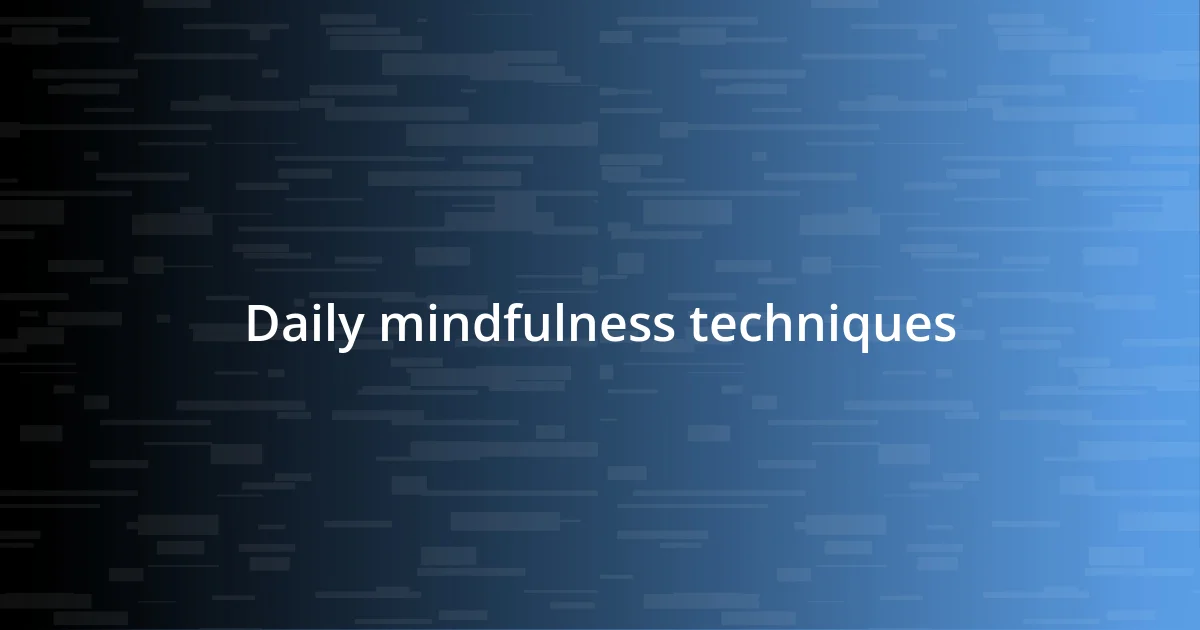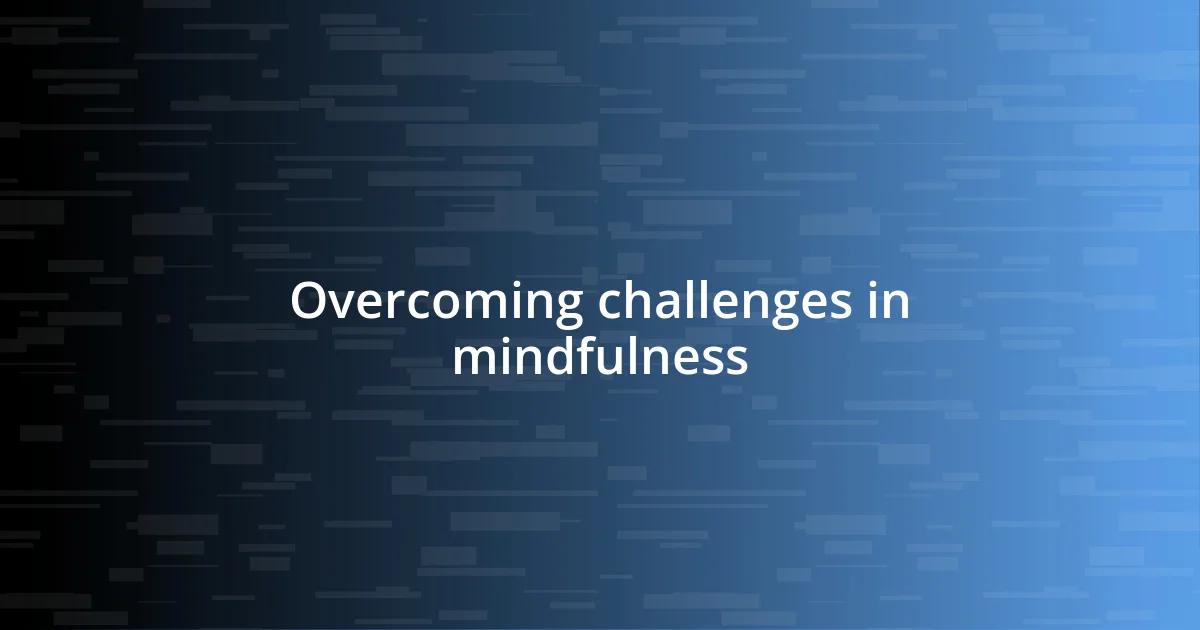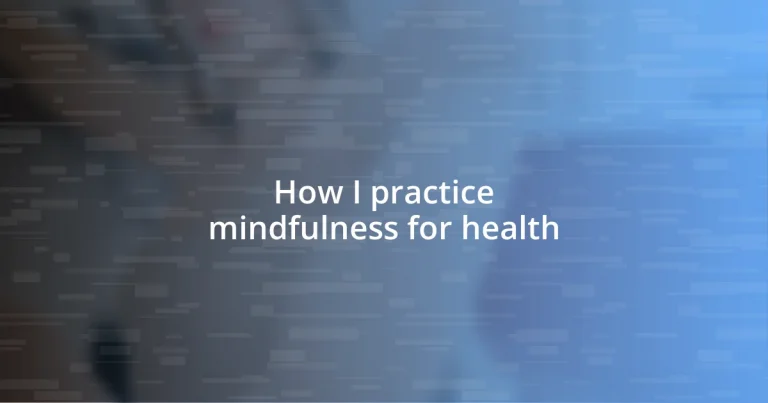Key takeaways:
- Mindfulness practice enhances well-being by fostering presence, reducing stress, and improving emotional regulation.
- Daily techniques like the Five Senses Exercise, mindful walking, and guided meditation help integrate mindfulness into everyday life.
- Tracking progress through journaling and sharing experiences with others enhances accountability and reflects personal growth in mindfulness practice.

Understanding mindfulness practice
Mindfulness practice centers on being fully present in the moment, embracing your thoughts, feelings, and bodily sensations without judgment. I remember a time when I was overwhelmed with stress from work; taking just a few minutes to focus on my breathing made a remarkable difference. Isn’t it amazing how just a deep breath can reground you in a chaotic world?
At its core, mindfulness invites us to step back from our usual thoughts and tune into the now. Picture this: I often find myself sipping tea in silence, allowing the warmth to fill me while I appreciate the flavor. In moments like these, I realize how often we rush past simple pleasures. Have you ever noticed how the act of savoring a moment can transform your day?
The beauty of mindfulness lies in its accessibility; you can practice it anywhere, from a quiet park to a bustling city street. I’ve often taken moments in the midst of a hectic day to pause and notice my surroundings. I ask myself, “What do I see, hear, and feel right now?” Engaging with the present in this way creates a deeper connection to both myself and the world around me.

Benefits of mindfulness for health
Mindfulness has become a powerful tool for enhancing health in countless ways. Personally, I’ve noticed that when I dedicate time to mindfulness, my stress levels decrease significantly. The physical sensations of tension in my shoulders and neck dissipate as I focus on my breath. When I incorporate mindfulness into my routine, it feels like giving my body a reset, allowing me to face challenges with a clearer mind.
Here are some key health benefits of mindfulness:
- Reduced Stress: Mindfulness techniques lower cortisol levels, the hormone associated with stress.
- Improved Emotional Regulation: Practicing mindfulness helps me respond to emotions rather than react impulsively.
- Enhanced Focus and Concentration: I often find that my ability to concentrate improves, making tasks seem less daunting.
- Better Sleep Quality: Engaging in mindfulness before bed has allowed my racing thoughts to settle, promoting deeper sleep.
- Lower Blood Pressure: I’ve read that regular practice can help lower blood pressure, contributing to heart health.
- Increased Resilience: Mindfulness fosters a sense of resilience, enabling me to bounce back from setbacks more effectively.
It’s remarkable how simply being present can open doors for better health and well-being in our lives. Mindfulness fosters a sense of connection that extends beyond just the moment, enriching our overall health experience.

Daily mindfulness techniques
Engaging in daily mindfulness techniques can truly reshape how we approach our lives. One method I particularly love is the “Five Senses Exercise.” It’s as simple as pausing for a moment to notice five things I can see, four I can touch, three I can hear, two I can smell, and one I can taste. This sensory engagement grounds me, bringing an acute awareness to the present that often feels refreshing, almost like a mini-vacation in my busy schedule.
Another technique I often use is mindful walking. I remember a day when I took my regular path through the park but decided to slow down and truly experience the walk. As I walked, I focused on each step, feeling the connection between my feet and the ground beneath me. That day, every rustle of leaves and chirp of birds seemed amplified. It’s incredible how reimagining a familiar routine can shift my perspective and evoke joy in everyday moments.
Lastly, incorporating guided meditation into my day has been transformative. There are times when I sit for just ten minutes, guided by a soothing voice on my favorite app. During these sessions, I allow myself to be carried away from my daily concerns and into a space of tranquility. I often emerge feeling lighter, a bit like stepping out of a cozy warm bath into a refreshing atmosphere — rejuvenated and ready to embrace whatever comes next.
| Technique | Description |
|---|---|
| Five Senses Exercise | Engaging all five senses to become fully present in the moment. |
| Mindful Walking | Taking time to concentrate on each step and the environment around you. |
| Guided Meditation | Listening to a meditative guide to promote relaxation and mindfulness. |

Mindfulness meditation for beginners
Mindfulness meditation provides an approachable entry point for beginners looking to enhance their well-being. I still remember my first session; I was skeptical yet curious, sitting cross-legged on the floor with a mix of excitement and nervousness. The key is to start simple—finding a comfortable position, focusing on your breath, and letting thoughts come and go without judgment. It may seem challenging at first, but over time, I learned to embrace those drifting thoughts as part of the journey, almost like clouds drifting across a bright blue sky.
As a beginner, I found it helpful to set a timer for just five minutes; sometimes, less truly is more. During those early days, I noticed how my mind would wander to my to-do list or upcoming meetings. I would gently redirect my attention back to my breath, feeling a sense of accomplishment each time. Have you ever tried to meditate? It’s fascinating how something so simple can feel both grounding and liberating.
I recommend exploring different guided meditations to find what resonates with you. There was a particular session I stumbled upon that focused on self-compassion—something I desperately needed at the time. As I listened, tears streamed down my face, and I felt a wave of acceptance wash over me. This experience highlighted that mindfulness is more than just stillness; it’s about fostering kindness toward ourselves. For anyone starting out, remember to practice patience. Your journey is uniquely yours, and every session brings its own lessons.

Incorporating mindfulness into daily life
Incorporating mindfulness into daily life can often feel overwhelming, but it doesn’t have to be. I’ve found that even the simplest tasks can become moments of mindfulness. For instance, when doing dishes, I focus on the texture of the soap suds and the warmth of the water. I’ve come to appreciate how this small shift in attention can transform a mundane chore into a soothing ritual that clears my mind and centers my thoughts.
One of my favorite practices is the mindful morning. Instead of diving straight into emails and the day’s chaos, I dedicate the first ten minutes of my day to being present. I often sip my coffee while noticing its warmth against my fingers and the aroma wafting up. Have you ever paused to really taste your morning brew? It’s surprising how such a small act can set a positive tone for the entire day, allowing me to step into my tasks with a clarity that feels almost electric.
Another way I weave mindfulness into my life is by setting periodic reminders on my phone. These pop-ups prompt me to take a few breaths or reflect on what I’m grateful for in that moment. Occasionally, I forget the importance of these pauses, but when I remember, it feels like reconnecting with an old friend. How do you remind yourself to be present during your busy day? For me, those snapshots of awareness are small yet powerful anchors, helping me navigate life’s ups and downs with a steadier heart.

Overcoming challenges in mindfulness
I often find that my biggest hurdle in practicing mindfulness arises from the noise of daily life. Just last week, I attempted to meditate during a particularly hectic day. With my kids playing loudly in the background and my phone buzzing with notifications, focusing felt nearly impossible. But then I remembered something essential: mindfulness isn’t about achieving silence. Instead, it’s about finding calm amidst the chaos. I adjusted my expectations and put on noise-canceling headphones, allowing me to create a little oasis of tranquility in my mind. Have you ever noticed how just a tiny change in your environment can shift your focus?
Sometimes, I struggle with feelings of impatience or frustration when trying to practice mindfulness. It can be disheartening to realize that my mind is racing in ten different directions. I recall a specific instance when I set a goal to meditate for twenty minutes. Midway through, I got caught up in thoughts about dinner plans and an upcoming deadline. Instead of pushing those thoughts away—something I used to do—I learned to acknowledge them with curiosity. “Why am I so preoccupied?” I asked myself. Understanding the reason behind those distractions allowed me to gently steer my focus back to my breath.
Technology poses its own challenges when I’m trying to embrace mindfulness. I often notice how easily I can get sucked into my phone’s vortex. To combat this, I’ve established “phone-free” zones—a practice I stumbled upon after a particularly distracting weekend. Now, whenever I’m at the dining table or in my meditation space, my phone stays in another room. This small boundary has transformed my meals and meditative moments into truly immersive experiences. How about you? Have you set any boundaries to reclaim your mindfulness practice?

Tracking progress in mindfulness practice
Tracking progress in mindfulness practice isn’t always straightforward, but I’ve discovered that documenting my journey can be incredibly enlightening. I keep a mindfulness journal where I jot down my thoughts and feelings after each session. This simple act helps me recognize patterns in my practice. Have you ever looked back to see how far you’ve come? There’s a certain satisfaction in witnessing your growth, even amidst the challenges.
One approach that has proved beneficial for me is using an app that tracks my meditation minutes and moods. Initially, I was skeptical—how could an app reflect my inner calm? But as I looked back at my stats, I began to appreciate the progression. For instance, I saw how my average duration gradually increased, just like my capacity to stay present. Those numbers became more than just data; they started to reflect a journey. How do you keep track of your mindfulness practices?
I’ve also found that sharing my experiences with friends creates a sense of accountability. During a recent gathering, I spoke with a close friend about my challenges with distractions during meditation. To my surprise, she shared her own struggles, and we ended up creating a mini support group. By checking in with each other regularly, we celebrate milestones together, which makes the journey feel less solitary. Sometimes, just knowing that someone else is on a similar path can be immensely motivating, don’t you think?














